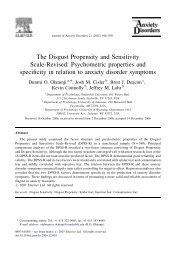574 B.J. Deacon, J.S. Abramowitz / Anxiety Disorders 19 (2005) 573–585<strong>Obsessive</strong>–compulsive disorder (OCD) is an anxiety disorder involving: (a)senseless intrusive thoughts, doubts, images, or impulses that evoke anxiety anddistress (Obsessions; e.g., thoughts <strong>of</strong> contamination, unwanted impulses to harmfriends) and (b) the intentional performance <strong>of</strong> compulsive rituals and otherneutralization strategies (Washing, Checking, Praying) aimed at reducing obsessionaldistress or preventing feared consequences. <strong>The</strong> most widely used clinician-administeredinterview for assessing the severity <strong>of</strong> OCD is the <strong>Yale</strong>-<strong>Brown</strong><strong>Obsessive</strong> <strong>Compulsive</strong> <strong>Scale</strong> (Y-BOCS; Goodman et al., 1989a, 1989b). <strong>The</strong> Y-BOCS, which is used consistently in research evaluating the effectiveness <strong>of</strong>pharmacological and cognitive-behavioral treatments for OCD, consists <strong>of</strong> twoparts: a symptom checklist and a severity measure. Comprehensive reviews <strong>of</strong> thepsychometric literature (e.g., Taylor, 1995, 1998) suggest that the severitymeasure possesses sound reliability, validity, and sensitivity to treatment. Forthis reason, the Y-BOCS is widely considered the ‘‘gold standard’’ measure <strong>of</strong>OCD severity.Items included on the Y-BOCS were rationally derived based on the developers’clinical experience and the DSM-III (American Psychiatric Association,1980) diagnostic criteria for OCD (Goodman et al., 1989a, 1989b). <strong>The</strong> severitymeasure contains 10 core items that assess obsessions and compulsions separatelyon five dimensions: time, interference, distress, resistance, and control. Each itemis rated from 0 (no symptoms) to 4 (severe symptoms); accordingly, the scaleyields a total score (range: 0–40) as well as subscale scores for Obsessions andCompulsions (range: 0–20 for each). Six investigational items were also includedin the original measure to assess characteristics associated with OCD symptomseverity (e.g., avoidance, pathological responsibility, insight). However, moststudies report results only from the 10 core items, and the psychometric properties<strong>of</strong> the investigational items have not been adequately examined. <strong>The</strong> scale’s corecomposition thus reflects a conceptualization <strong>of</strong> OCD in which the severity <strong>of</strong>obsessions and compulsions contribute independently to the global severity <strong>of</strong> thedisorder.It is important to examine the factor structure <strong>of</strong> the Y-BOCS to verify whetherOCD symptom severity is best conceptualized according to the subscale compositionproposed by Goodman et al. (1989a). To this end, six studies have reportedfactor analyses <strong>of</strong> the Y-BOCS severity scale. <strong>The</strong> results <strong>of</strong> these studies aresummarized in Table 1. As can be seen, findings have been inconsistent withauthors reporting one-, two-, or three-factor solutions. In some studies obsessionsand compulsions form distinct factors (e.g., McKay, Danyko, Neziroglu, &Yaryure-Tobias, 1995), whereas in others common features <strong>of</strong> obsessions andcompulsions (e.g., interference and distress) load together on the same factor(e.g., Amir, Foa, & Coles, 1997). This evidence for instability <strong>of</strong> the Y-BOCS’factor structure raises questions about whether OCD severity distills neatly intoobsessions and compulsions as is traditionally thought.In addition, there is evidence that the items measuring resistance to obsessionsand compulsions (items 4 and 9, respectively) do not fit well with the other eight
B.J. Deacon, J.S. Abramowitz / Anxiety Disorders 19 (2005) 573–585 575Table 1Factor analytic studies <strong>of</strong> the Y-BOCS Severity <strong>Scale</strong>StudyY-BOCSversionAnalyticprocedureFactors and itemsFals-Stewart (1992) 16-item a EFA Global impairment from OCD (1–16)Kim et al. (1994) 10-item EFA Severity <strong>of</strong> obsessions (1, 2, 3, 5)Severity <strong>of</strong> compulsions (6, 7, 8, 10)Resistance to symptoms (4, 9)McKay et al. (1995) 10-item CFA Obsessions (1, 2, 3, 4, 5)Compulsions (6, 7, 8, 9, 10)Amir et al. (1997) 10-item CFA Disturbance (2, 3, 7, 8)Symptom severity (1, 4, 5, 6, 9, 10)McKay et al. (1998) 10-item CFA Obsessions (1, 2, 3, 4, 5)Compulsions (6, 7, 8, 9, 10)CFA Disturbance (2, 3, 7, 8)Symptom severity (1, 4, 5, 6, 9, 10)Moritz et al. (2002) 12-item EFA Severity <strong>of</strong> obsessions (1, 1b, 2, 3, 5)Severity <strong>of</strong> compulsions (6, 6b, 7, 8, 10)Resistance to symptoms (4, 9)10-item EFA and CFA Severity <strong>of</strong> obsessions (1, 2, 3, 5)Severity <strong>of</strong> compulsions (6, 7, 8, 10)Resistance to symptoms (4, 9)Note. EFA: exploratory factor analysis; CFA: confirmatory factor analysis.Y-BOCS items: 1: time with obsessions; 1b: obsession-free interval; 2: interference from obsessions;3: distress from obsessions; 4: resistance to obsessions; 5: control over obsessions; 6: time withcompulsions; 6b: obsession-free interval; 7: interference from compulsions; 8: distress fromcompulsions; 9: resistance to compulsions; 10: control over compulsions; 11: insight into OCDsymptoms; 12: avoidance; 13: indecisiveness; 14: pathological responsibility; 15: slowness; 16:pathologic doubting.a 1b and 6b were excluded from Fals-Stewart’s (1992) analysis <strong>of</strong> the 16-item version.Y-BOCS severity items. Inspection <strong>of</strong> the factor loadings reported in theindividual studies listed in Table 1 indicates that these items either form theirown factor (e.g., Kim, Dysken, Pheley, & Hoover, 1994; Moritz et al., 2002) ordemonstrate the weakest factor loadings in two-factor solutions (e.g., McKayet al., 1995; McKay, Neziroglu, Stevens, & Yaryura-Tobias, 1998). <strong>The</strong> resistanceto compulsions item also showed weak correlations with the Y-BOCS total andsubscale scores in a study by Woody, Steketee, and Chambless (1995). Moreover,both resistance items showed poor sensitivity to medication treatment in a studyby Kim et al. (1994).Factor analysis allows researchers to make inferences about the nature <strong>of</strong> aconstruct by examining the factor structure <strong>of</strong> a valid measure <strong>of</strong> that construct.Accordingly, previous factor analyses <strong>of</strong> the Y-BOCS have been used to generatehypotheses regarding the nature <strong>of</strong> OCD symptom severity. For example, on the




